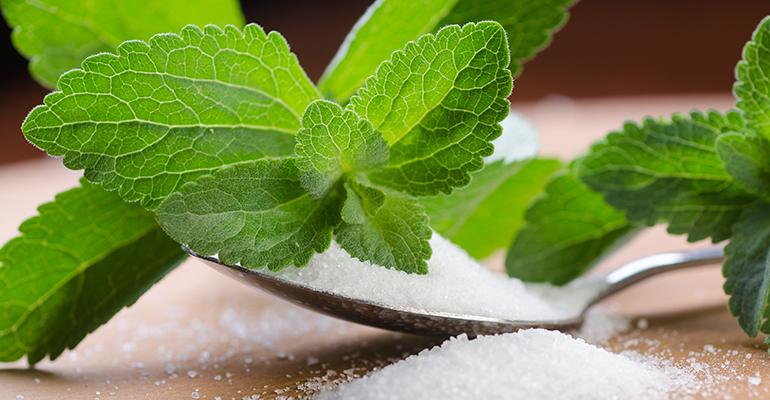News
EU approves stevia produced via enzymatic conversion
16 Aug 2021The European Commission has approved use of the enzymatically converted stevia molecule, Reb M, for use in the EU.
Producing stevia via enzymatic conversion (also known as bioconversion) involves using genetically modified yeast to scale up the best-tasting rebaudioside molecules found in the stevia leaf although the GM yeast is not present in the final ingredient.

In 2019, scientists at the European Food Safety Authority (EFSA) concluded that stevia’s existing Acceptable Daily Intake (ADI) of 4 mg per kilo of body weight per day could also be applied to Reb M produced via enzyme modification.
Based on EFSA’s scientific opinion and recommendations, policymakers at the European Commission approved the use of enzymatically bioconverted stevia last month.
“The Authority […] concluded that rebaudioside M produced by enzyme modification of steviol glycosides, using UDP-glucosyltransferase and sucrose synthase enzymes produced by the genetically modified yeasts K. phaffii UGT-a and K. phaffii UGT-b, would not be of safety concern for the same proposed uses and at the same use levels as steviol glycosides (E 960).
“Therefore, it is appropriate to authorise the use of rebaudioside M produced via the enzymatic step process as a sweetener in the food categories where steviol glycosides (E 960) are currently authorised,” said the Commission in the regulation, which was published in the Official Journal of the European Union on 13 July 2021 and entered into force 20 days later.
Stevia produced via bioconversion can also be listed under the E number ‘E 960c’. The final additive must contain a minimum of 95% rebaudioside M and must be free from any viable cells of the genetically modified yeasts, K. phaffii UGT-a and K. phaffii UGT-b, or their DNA, which are used to produce the low-calorie sweetener.
Scaling up ‘trace amounts’ of the best-tasting glycosides
US company Sweegen, which produces stevia via bioconversion, welcomed the recent regulation.
Michael Halvorsen, senior director of business development, EMEA at Sweegen told The Ingredients Network: “The advantage of bioconversion is that we are able to make the best-tasting sweetener molecules because we start from the nature-based source, such as the stevia leaf, and use enzymatic conversion to convert compounds in the stevia leaf to best tasting sweetener molecules. It is remarkable how science has advanced us to uncover these precious rebaudiosides found in trace amounts of the stevia leaf.”
Another advantage of bioconversion is that it meets the requirements of the non-GMO Project Verified group, allowing for a certified non-GMO on pack claim. Sweegen’s Reb M is certified by the non-GMO Project Verified group in the US.
Halvorsen said Sweegen would consider non-GMO certification for its Signature Bestevia Reb M in Europe if its customers showed interest in this label. The company is also confident its other Reb molecules will be approved for the EU market.
“We anticipate the approval of our other portfolio of stevia ingredients, including Reb D and E,” he added.
Sweegen’s Signature Bestevia Reb M, which must be labelled on pack as ‘enzymatically produced steviol glycosides’ when sold in the EU, will be produced at the supplier’s manufacturing facility in Eastern Europe.
‘No added sugar’ claims still on the rise in Europe
‘No added sugar’ claims are growing in Europe, according to market research company Mintel. The UK has the highest proportion (15%) of European food and drink launches carrying this claim, followed by Germany (13%) and France (10%). In Poland, ‘no added sugar’ claims have doubled since 2016, reaching 9% of food and drink launches in 2021.
Ingredients that are being used to meet this demand for low-sugar products include functional fibres and ‘next-generation stevia’, said Mintel.
Neha Srivastava, food and drink patent analyst at Mintel, said: “Consumers are aware of the importance of fibres in maintaining gut health. Brands can leverage this awareness by repositioning them as a multifunctional health ingredient that helps reduce sugar content in food and drink whilst improving gut health.
“Stevia continues to gain traction in food and drink launches because of its naturalness and zero calorific value, but its bitter and lingering aftertaste remains a significant barrier. Recent patent innovations to improve taste issues and physicochemical properties, like purity and solubility, to produce next-generation stevia may help overcome the challenge,” Srivastava wrote in an online blog post.
“Innovators are looking for alternative approaches, such as the use of sweet flavouring agents and aromas as a promising option to reduce sugar content in new food and drink products – especially in dairy desserts. This can be a promising option to reduce sugar content by providing sweet perception in brain cells.”
